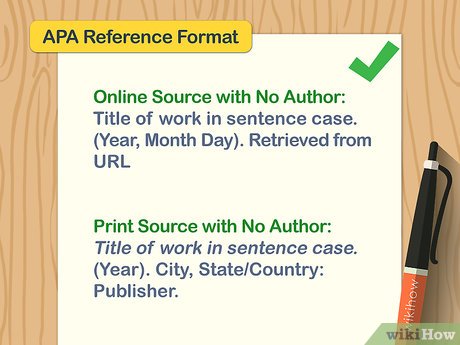Ever stumbled upon an online article brimming with information, perfect for your research paper, only to find it conspicuously devoid of an author’s name? You’re not alone. Citing sources correctly is paramount in academic integrity, and the absence of an author presents a unique, but navigable, challenge in APA style.
Let’s embark on a journey to unravel the intricacies of citing these elusive online articles, ensuring your bibliography remains a bastion of accuracy and adherence to APA guidelines.
I. The Quandary of the Authorless Article: Identifying the Core Elements
Before diving into the mechanics of citation, it’s crucial to dissect the article and identify the key pieces of information we can salvage. Think of it as forensic investigation for your bibliography.
A. Title of the Article: This is your primary identifier. Treat it with reverence. Make sure to record it exactly as it appears.
B. Name of the Website: Where did you unearth this gem? Is it a reputable news site, a corporate blog, or something else entirely?
C. Publication or Update Date: The more recent, the better, generally speaking. Hunt for any indication of when the article was published or last modified. If none exists, indicate that.
D. URL: The digital address of the article. Copy and paste with extreme care to avoid errors.
II. Constructing the Reference List Entry: A Symphony of Parentheticals and Italics
The reference list entry is the cornerstone of your citation. It’s where you provide the full details of the source for your readers to locate it themselves.
A. When the Author is Absent, the Title Takes the Helm: Start your reference list entry with the title of the article. Enclose it in quotation marks if it’s a short article or a section of a larger work. If the title refers to an entire website, italicize it instead.
B. Navigating Corporate Authorship: If a corporate entity (e.g., a company or organization) is clearly responsible for the content, use the corporate author in place of an individual author. For example, “National Institute of Mental Health.”
C. The Publication Date: A Temporal Anchor: Include the publication date, if available, in parentheses. Use the format (Year, Month Day) if all elements are present. If only the year is available, use (Year). If there’s no date provided, use (n.d.) for “no date.” This indicates the temporal context of your source.
D. The Website’s Role: The Provenance of Information: After the title and date, include the name of the website. This provides context for the article’s origin.
E. The All-Important URL: A Digital Pathway: Conclude the reference list entry with the full URL of the article. Make it a direct link to the specific page you cited.
Example:
“The Future of Artificial Intelligence.” (2023, October 26). *TechForward Insights*. https://www.techforwardinsights.com/ai-future
III. In-Text Citations: Brevity and Clarity in the Body of Your Work
In-text citations are the short, parenthetical notes within your text that point back to the full reference list entry.
A. Truncated Titles in Parentheses: Since there’s no author, use a shortened version of the article title in the in-text citation. If the title is short already, you may use the entire title. Be sure to include the year to provide full context.
B. Title Case Considerations: The shortened title in your in-text citation should follow title case capitalization, even if the original title on the website doesn’t. For example: (“Future Trends,” 2023).
C. Page Numbers (When Available): If the online article is a PDF or otherwise paginated, include the page number(s) where the cited information appears.
Example:
(“Future Trends,” 2023, p. 5) suggests that…
IV. When All Else Fails: Handling the Unfathomable Absence of Key Data
Sometimes, even the most diligent detective work yields incomplete results. What happens when the date, website, or even a coherent title is missing?
A. No Date (n.d.): We’ve already touched upon this, but it’s worth reiterating. Use “(n.d.)” when the publication date is nowhere to be found.
B. Website Name Inference: If the website name is not explicitly stated, try to infer it from the URL. For instance, if the URL is “blog.example.com,” you might infer the website name is “Example Blog.”
C. Descriptive Titles: In extreme cases, if the article lacks a proper title, create a brief, descriptive title enclosed in square brackets. For example: “[Report on Climate Change Impacts].”
V. Ensuring Consistency and Accuracy: The Hallmarks of Scholarly Rigor
The key to flawless citations is meticulousness and consistency.
A. Double-Check Every Detail: Before submitting your work, scrutinize every reference list entry and in-text citation. Errors can creep in easily.
B. Maintain a Consistent Style: Apply the principles outlined above consistently throughout your paper. This demonstrates attention to detail and respect for academic conventions.
C. Consult Official APA Resources: When in doubt, refer to the official APA Publication Manual. It is the definitive guide to all things APA style. Seek out the most recent edition to adhere to latest standard.
Mastering the art of citing online articles with no author in APA style might seem daunting initially, but with a methodical approach and a dash of bibliographic diligence, you can conquer this challenge and ensure your research shines with impeccable accuracy and academic integrity. Good luck!
